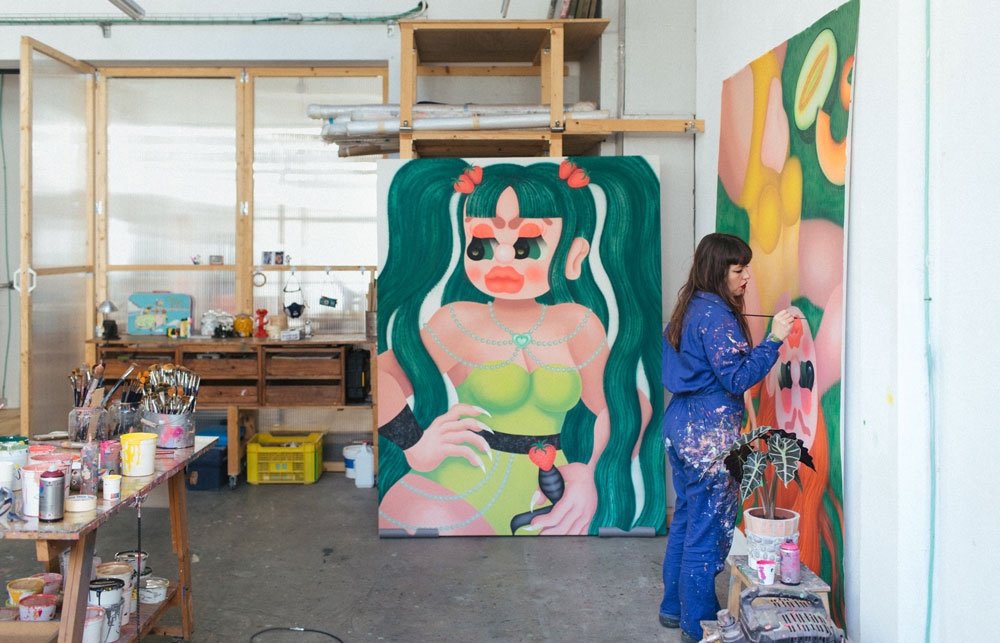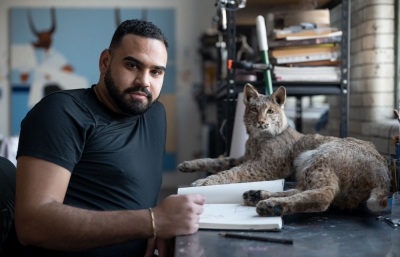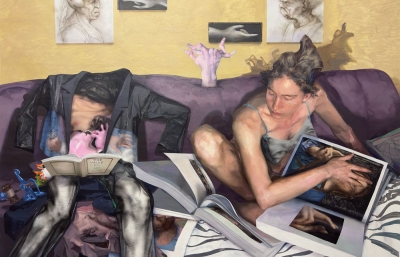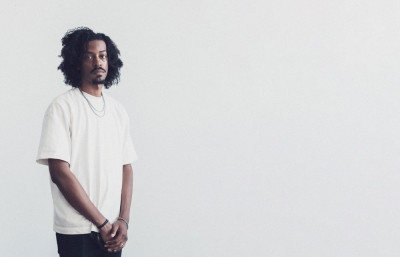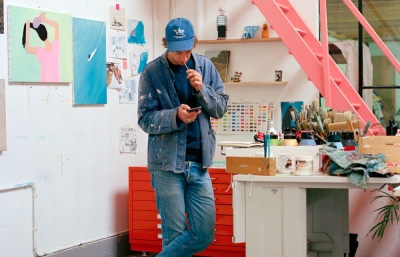Fátima de Juan
Fruit Force Femme
Interview by Kristin Farr // Portrait by Sandra Calpe
In the hands of Fátima de Juan, everything, even a boot or crocodile, exudes main character energy. Over two short years, a vast army of burly femme warriors has stormed the artist’s castle, proliferating in her studio with portraits that demand attention and affection. These powerful figures were born after the artist spent years writing Xena on walls and painting murals in the streets of Spain and internationally. She has now entered her full-blown Amazonian era, leaving tires screeching and eyes popping with each monumental new portrait.
There is a singular, sweet superpower in de Juan’s new work, a confidence built from a resourceful foundation. She is a luminous example of street art’s sometimes seamless transition into galleries—resonant references like hers continue to reverberate and are deft at capturing a broad array of gazes. Time and identity are somewhat collapsed in her work, representing the exploration of an archetype that feels both new and nostalgic. Her warrior princess witches are protective forces forming their own fantastical reality of charming strength. They could hug you or club you, and you’d be delighted either way.

Kristin Farr: Are you a witch?
Fátima de Juan: I have the broom parked outside and a stray black cat.
Why did the 1980s television show, Xena, Warrior Princess resonate with you so much?
It was one of the few TV series when I was a child in which the main character was a super woman, a heroine of brute strength, a warrior admired by women and feared by men—the rest were TV series where the girls fought to be the prettiest and most popular in high school, and I hated that tremendously. I wanted to be Serena Williams, not the pretty one in high school! Over the years, many people joked about my physical resemblance to the warrior princess, hence the name Xena, which I have been writing on walls for years.
Tell me about your time growing up in Mallorca and how you got into painting walls.
I was obsessed with female warriors, graffiti, muscly girls, suburban aesthetics, witches, and girl gangs. I always liked drawing since I was a child, and as a teenager, I felt very attracted to graffiti: the fact of painting in public spaces, the way it was done, its colors, I liked its language codes, and wild forms rejected by ordinary citizens. At that moment I started to paint graffiti with my sister. It was the moment of the "click" in which I started to build what I am now.

What are your recent obsessions?
They are still very much like the ones I had as a child—strong and inspiring women always.
What does painting allow you to express that can’t be explained otherwise?
Everything—interpreting emotions, telling stories without saying a word. It is a moment of catharsis, since pictorial language gives you creative freedom, as well as freedom of interpretation, when it comes to expressing unconscious and abstract desires. Often you create without thinking about what you want to tell; you are guided by instinct, desire, and impulse. Then, once the work is finished, the story reveals itself to you and reveals everything you wanted to express, which, until now, had not found a way. It’s been said, "We think we invent stories, on the contrary, stories invent us, shaping our personality.”
What has changed most about your artwork in the last couple of years?
The way I approach the canvas and the context. For some years now, I've been doing more introspective work in the studio, timings are different, and so are the supports. I'm looking for different things, I've closed the spectrum and focused more on myself and my personal search. For me, this change of optics has been a challenge and an opportunity that life has given me to change my angle of vision and to enjoy another perspective. I feel blessed for that.

Are your figures self-portraits? Do you have a muse?
My inner girl. I suppose there is something of a self-portrait in all of them. They are women who live in my personal imagination, they are my girl gang, there is something of my alter-ego in all of them.
What kind of balances comes up in your practice?
It's hard to set limits when you work on what you like. Not knowing how to stop working on what you like makes you become obsessively immersed in creation, and sometimes you forget mundane things like going shopping or eating on time. Also, the eternal struggle between creativity and productivity—when creating becomes your profession, economic and productive factors come into play, and finding the balance between these two heavyweights is key. I try to allow inspiration to catch me working.
Your figures’ fashions are so fresh, they even stand on their own, like the series of boots.
Years ago, I studied fashion design, but I gave it up because I felt like an octopus in a garage. I don't fit into that industry, nor do I share its canons of beauty, although it's to be thankful that, in recent years, the diversity of non-normative bodies and faces has increased. Even so, there is an indestructible, armored glass ceiling. I see fashion as a means of artistic and creative expression. In my painting, it plays a symbolic role. It is a space for self-affirmation, a kind of fantasy shield that exalts the character.
The “dino-shoes,” for example, is a concept that has been in my head for many years. I would love to have some real ones to wear myself! The idea is to create a dress code for contemporary Amazons and Dinomamis who are on the move.

Tell me more about the symbolism in your work.
Fruit is always present in my work, its pure connection with the earth, and, at the same time, its erotic power and an irresistible color. Fruit is a symbol of abundance and of the eternal feminine. The crocodile represents the wildest, most ironic part. Often the women also appear together with other animals such as spiders or cats, which makes it a kind of double self-portrait, where woman and animal identify with each other and create dialogues between them.
Often, other elements appear, such as swords, weapons, water pistols... armed girls who know how to defend themselves on their own, a more modern readaptation of the concept of a warrior, with touches of fantasy and personal imagination.
It should be noted that your paintings are huge. What do you like about working at a large scale?
It's a format that comes from graffiti. I love painting characters bigger than me and feeling small in front of the painting. I never liked drawing in small notebooks; it makes me feel very limited.
When you work on a large scale, you paint with your whole body, and it's a much more physical artwork. Sometimes you dance, sometimes you fight, but it's much more direct, face-to-face.
What is something you hope people feel when they view your work?
I hope it makes an impact in one way or another that doesn't leave you indifferent—that it conveys strength, sensitivity, and a lot of power.
What makes you feel powerful?
Being able to work as an artist makes me feel powerful. To be self-sufficient, have my own space where I can create and feel free; independence from the social establishment, to be able to live according to my rules and my time, to have my own concept of success. To recognize myself in my own work and to grow through it. Love, nature, music.

You have worked in installation formats previously—are you working on any sculptures now? The yellow industrial scaffold under your painting at the Untitled fair last year reminded me of your past materials.
At the moment, I've been concentrating on painting for the last two years, although I don't rule out working on sculptures or installations in the near future. Years ago, I made some installations with construction elements such as brick altars or installations with grilles. They speak of the space in which I have grown up as an artist, and many of them belong to abandoned places where I have gone to paint, and they represent me in some way.
The idea for the installation with the scaffolding at Untitled came from Óscar, the director of L21 Gallery, and yes, it has that under-construction vibe that I like a lot. It gives it that half-finished, industrial touch that I love, and takes away its sobriety and rigidity. I really like his exhibition setups and the way he approaches space, he's daring and takes a gamble.
What are your main materials?
Acrylic, spray paint, and airbrush.
Artists with mural and graffiti backgrounds tend to fill all the space in a composition. Does it feel freeing to make these portraits with more white space in the background?
It's true that white space is managed differently on a mural than on a canvas. I like leaving blank space in the raw canvas, just as I enjoyed painting on a blank wall, which is not very common when it comes to walls, and in the end, you invent compositional resources to readapt to the space. In the case of the canvas, I try to make it breathe, to let the material show through as I play with that advantage. The white space has undoubtedly taken on a different meaning.

Can you also tell me about your colored frames that seem to make the paintings glow?
It's a very stunning element and, at the same time, subtle. I like how the fluorescent colors reflect the light and separate the canvas from the wall. I like the fact that the frame is part of the work as a whole.
Tell me about your recent travels and any favorite cities your art has led you to.
My last trip was to South Korea for the Kiaf fair. It was my first time in Asia and I was really looking forward to seeing my work exhibited outside of Europe and seeing the feedback from people.
I traveled to Canada years ago to paint a huge mural in Edmonton and I took the opportunity to see Banff and Jasper National Parks in British Columbia. I think it is the most beautiful thing I have ever seen in my life. There has been nothing like it, the color of its glacial lakes and its gigantic forests. I dream every day of going back there. Canada and Cuba are my favorite places to date.
What are you working on in the studio currently?
I am working on a series of pieces for ArcoMadrid 2023 together with L21 Gallery (Editor's note: the fair opened this past weekend!)
Describe your ideal planet.
Jurassic and tropical, with giant, beautiful, burly female warriors surrounded by palm trees and exotic fruits—with Amazons riding dinosaurs and giant crocodiles, and big-cheeked cats to cuddle!

